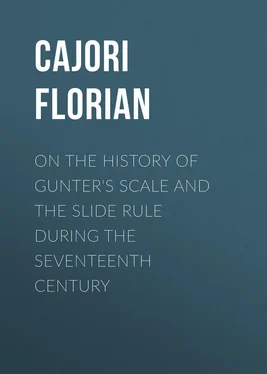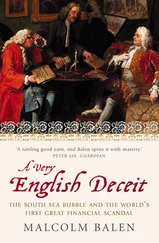Florian Cajori - On the History of Gunter's Scale and the Slide Rule during the Seventeenth Century
Здесь есть возможность читать онлайн «Florian Cajori - On the History of Gunter's Scale and the Slide Rule during the Seventeenth Century» — ознакомительный отрывок электронной книги совершенно бесплатно, а после прочтения отрывка купить полную версию. В некоторых случаях можно слушать аудио, скачать через торрент в формате fb2 и присутствует краткое содержание. ISBN: , Издательство: Иностранный паблик, Жанр: foreign_antique, foreign_prose, на английском языке. Описание произведения, (предисловие) а так же отзывы посетителей доступны на портале библиотеки ЛибКат.
- Название:On the History of Gunter's Scale and the Slide Rule during the Seventeenth Century
- Автор:
- Издательство:Иностранный паблик
- Жанр:
- Год:неизвестен
- ISBN:http://www.gutenberg.org/ebooks/42216
- Рейтинг книги:4 / 5. Голосов: 1
-
Избранное:Добавить в избранное
- Отзывы:
-
Ваша оценка:
- 80
- 1
- 2
- 3
- 4
- 5
On the History of Gunter's Scale and the Slide Rule during the Seventeenth Century: краткое содержание, описание и аннотация
Предлагаем к чтению аннотацию, описание, краткое содержание или предисловие (зависит от того, что написал сам автор книги «On the History of Gunter's Scale and the Slide Rule during the Seventeenth Century»). Если вы не нашли необходимую информацию о книге — напишите в комментариях, мы постараемся отыскать её.
On the History of Gunter's Scale and the Slide Rule during the Seventeenth Century — читать онлайн ознакомительный отрывок
Ниже представлен текст книги, разбитый по страницам. Система сохранения места последней прочитанной страницы, позволяет с удобством читать онлайн бесплатно книгу «On the History of Gunter's Scale and the Slide Rule during the Seventeenth Century», без необходимости каждый раз заново искать на чём Вы остановились. Поставьте закладку, и сможете в любой момент перейти на страницу, на которой закончили чтение.
Интервал:
Закладка:
Florian Cajori
On the History of Gunter's Scale and the Slide Rule during the Seventeenth Century
I. INTRODUCTION
In my history of the slide rule 1 1 F. Cajori, History of the Logarithmic Slide Rule and Allied Instruments , New York, 1909, pp. 7-14, also Addenda i-vi.
, and my article on its invention 2 2 F. Cajori, “On the Invention of the Slide Rule,” in Colorado College Publication , Engineering Series Vol. 1, 1910. An abstract of this is given in Nature (London), Vol. 82, 1909, p. 267.
it is shewn that William Oughtred and not Edmund Wingate is the inventor, that Oughtred’s circular rule was described in print in 1632, his rectilinear rule in 1633. Richard Delamain is referred to as having tried to appropriate the invention to himself 3 3 F. Cajori, History etc., p. 14.
and as having written a scurrilous pamphlet against Oughtred. All our information about Delamain was taken from De Morgan, 4 4 Art. “Slide Rule” in the Penny Cyclopaedia and in the English Cyclopaedia [Arts and Sciences].
who, however, gives no evidence of having read any of Delamain’s writings on the slide rule. Through Dr. Arthur Hutchinson of Pembroke College, Cambridge, I learned that Delamain’s writings on the slide rule were available. In this article will be given: First, some details of the changes introduced during the seventeenth century in the design of Gunter’s scale by Edmund Wingate, Milbourn, Thomas Brown, John Brown and William Leybourn; second, an account of Delamain’s book of 1630 on the slide rule which antedates Oughtred’s first publication (though Oughtred’s date of invention is earlier than the date of Delamain’s alleged invention) and of Delamain’s later designs of slide rules; third, an account of the controversy between Delamain and Oughtred; fourth, an account of a later book on the slide rule written by William Oughtred, and of other seventeenth century books on the slide rule.
II. INNOVATIONS IN GUNTER’S SCALE
We begin with Anthony Wood’s account of Wingate’s introduction of Gunter’s scale into France. 5 5 Anthony Wood, Athenae oxonienses (Ed. P. Bliss), London, Vol. III, 1817, p. 423.
In 1624 he transported into France the rule of proportion, having a little before been invented by Edm. Gunter of Gresham Coll. and communicated it to most of the chiefest mathematicians then residing in Paris: who apprehending the great benefit that might accrue thereby, importun’d him to express the use thereof in the French tongue. Which being performed accordingly, he was advised by monsieur Alleawne the King’s chief engineer to dedicate his book to monsieur the King’s only brother, since duke of Orleans. Nevertheless the said work coming forth as an abortive (the publishing thereof being somewhat hastened, by reason an advocate of Dijon in Burgundy began to print some uses thereof, which Wingate had in a friendly way communicated to him) especially in regard Gunter himself had learnedly explained its use in a far larger volume. 6 6 The full title of the book which Wingate published on this subject in Paris is as follows: L’Vsage | de la | Reigle de | Proportion | en l’Arithmetique & | Geometrie. | Par Edmond Vvingate, | Gentil-homme Anglois. | Εἂν ἧς φιλεμαθὴς, ἕση ἥση πολυμαθὴς. In tenui, sed nõ tenuis vsusve, laborne. | A Paris, | Chez Melchior Mondiere, | demeurant en l’Isle du Palais, | à la | ruë de Harlay aux deux Viperes. | M. DC. XXIV. | Auec Priuilege du Roy. | Back of the title page is the announcement: Notez que la Reigle de Proportion en toutes façons se vend à Paris chez Melchior Tauernier, Graueur & Imprimeur du Roy pour les Tailles douces, demeurant en l’Isle du Palais sur le Quay qui regarde la Megisserie à l’Espic d’or.
Gunter’s scale, which Wingate calls the “rule of proportion,” contained, as described in the French edition of 1624, four lines: (1) A single line of numbers; (2) a line of tangents; (3) a line of sines; (4) a line, one foot in length, divided into 12 inches and tenths of inches, also a line, one foot in length, divided into tenths and hundredths.
The English editions of this book which appeared in 1623 and 1628 are devoid of interest. The editions of 1645 and 1658 contain an important innovation. 7 7 The title-page of the edition of 1658 is as follows: The Use of the Rule of Proportion in Arithmetick & Geometrie. First published at Paris in the French tongue, and dedicated to Monsieur, the then king’s onely Brother (now Duke of Orleance). By Edm. Wingate, an English Gent. And now translated into English by the Author. Whereinto is now also inserted the Construction of the same Rule, & a farther use thereof.. 2nd edition inlarged and amended. London, 1658.
In the preface the reasons why this instrument has not been used more are stated to be: (1) the difficulty of drawing the lines with exactness, (2) the trouble of working thereupon by reason (sometimes) of too large an extent of the compasses, (3) the fact that the instrument is not readily portable. The drawing of Wingate’s arrangement of the scale in the editions of 1645 and 1658 is about 66 cm. (26.5 in.) long. It contains five parallel lines, about 66 cm. long, each having the divisions of one line marked on one side and of another line on the other side. Thus each line carries two graduations: (1) A single logarithmic line of numbers; (2) a logarithmic line of numbers thrice repeated; (3) the first scale repeated, but beginning with the graduations which are near the middle of the first scale, so that its graduation reads 4, 5, 6, 7, 8, 9, 1, 2, 3; (4) a logarithmic line of numbers twice repeated; (5) a logarithmic line of tangents; (6) a logarithmic line of sines; (7) the rule divided into 1000 equal parts; (8) the scale of latitudes; (9) a line of inches and tenths of inches; (10) a scale consisting of three kinds, viz., a gauge line, a line of chords, and a foot measure, divided into 1000 equal parts.
Important are the first and second scales, by which cube root extraction was possible “by inspection only, without the aid of pen or compass;” similarly the third and fourth scales, for square roots. This innovation is due to Wingate. The 1645 edition announces that the instrument was made in brass by Elias Allen, and in wood by John Thompson and Anthony Thompson in Hosier Lane.
William Leybourn, in his The Line of Proportion or Numbers, Commonly called Gunter’s Line, Made Easie , London, 1673, says in his preface “To the Reader:”
The Line of Proportion or Numbers, commonly called (by Artificers) Gunter’s Line, hath been discoursed of by several persons, and variously applied to divers uses; for when Mr. Gunter had brought it from the Tables to a Line, and written some Uses thereof, Mr. Wingate added divers Lines of several lengths, thereby to extract the Square or Cube Roots, without doubling or trebling the distance of the Compasses: After him Mr. Milbourn, a Yorkshire Gentleman, disposed it in a Serpentine or Spiral Line, thereby enlarging the divisions of the Line.
On pages 127 and 128 Leybourn adds:
Again, One T. Browne, a Maker of Mathematical Instruments, made it in a Serpentine or Spiral Line, composed of divers Concentrick Circles, thereby to enlarg the divisions, which was the contrivance of one Mr. Milburn a Yorkshire Gentleman, who writ thereof, and communicated his Uses to the aforesaid Brown, who (since his death) attributed it to himself: But whoever was the contriver of it, it is not without inconvenience; for it can in no wise be made portable; and besides (instead of compasses) an opening Joynt with thirds [threads] must be placed to move upon the Centre of the Instrument, without which no proportion can be wrought.
Читать дальшеИнтервал:
Закладка:
Похожие книги на «On the History of Gunter's Scale and the Slide Rule during the Seventeenth Century»
Представляем Вашему вниманию похожие книги на «On the History of Gunter's Scale and the Slide Rule during the Seventeenth Century» списком для выбора. Мы отобрали схожую по названию и смыслу литературу в надежде предоставить читателям больше вариантов отыскать новые, интересные, ещё непрочитанные произведения.
Обсуждение, отзывы о книге «On the History of Gunter's Scale and the Slide Rule during the Seventeenth Century» и просто собственные мнения читателей. Оставьте ваши комментарии, напишите, что Вы думаете о произведении, его смысле или главных героях. Укажите что конкретно понравилось, а что нет, и почему Вы так считаете.












